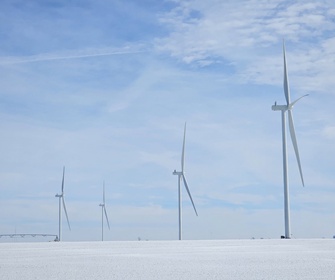A full-size prototype of the floating LIDAR offshore resource assessment system, known as FLIDAR, has been successfully tested 15km off the Belgian coast. It has been located next to a stationary LIDAR (WINDCUBEv2 LIDAR from Leosphere) on a fixed communication mast for the month of October, in order to test survivability and validate the accuracy of the wind speed measurements.
This is the first successful trial of a floating LIDAR device in real offshore conditions in the North Sea. Designed to withstand significant wave heights of over 6 metres the FLIDAR system was tested in wind speeds up to 25 m/s and proved highly accurate, with an r2 of over 0.99 when compared to reference LIDAR data. The FLIDAR was developed by 3E and OWA (Offshore & Wind Assistance NV), a 100% subsidiary of the Belgian geotechnical offshore contractor GeoSea. It is made up of an industry standard buoy adapted to marine regulations for faster permitting. The Leosphere WINDCUBEv2 Offshore LIDAR device is secured on top of a mechanical stabilisation system whilst a set of PV panels, small wind turbines and battery pack provide independent power supply. Data is retrieved and communicated via satellite to a web based monitoring and reporting tool. The results can also be coupled with a wind farm simulation model to allow real time analysis of key performance indicators for wind turbine energy conversion. The development of the FLIDAR floating LIDAR system is part of the Offshore Wind Infrastructure (OWI) project co-financed by the Flemish Government.
This is the first successful trial of a floating LIDAR device in real offshore conditions in the North Sea. Designed to withstand significant wave heights of over 6 metres the FLIDAR system was tested in wind speeds up to 25 m/s and proved highly accurate, with an r2 of over 0.99 when compared to reference LIDAR data. The FLIDAR was developed by 3E and OWA (Offshore & Wind Assistance NV), a 100% subsidiary of the Belgian geotechnical offshore contractor GeoSea. It is made up of an industry standard buoy adapted to marine regulations for faster permitting. The Leosphere WINDCUBEv2 Offshore LIDAR device is secured on top of a mechanical stabilisation system whilst a set of PV panels, small wind turbines and battery pack provide independent power supply. Data is retrieved and communicated via satellite to a web based monitoring and reporting tool. The results can also be coupled with a wind farm simulation model to allow real time analysis of key performance indicators for wind turbine energy conversion. The development of the FLIDAR floating LIDAR system is part of the Offshore Wind Infrastructure (OWI) project co-financed by the Flemish Government.








